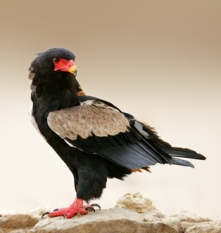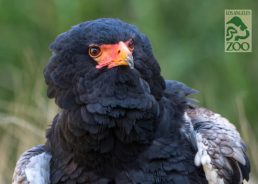Taxonomy:

- Kingdom: Animalia
- Phylum: Chordata
- Class: Aves
- Order: Accipitriforme
- Family: Accipitridae
- Genus: Tetrathopius
- Species: ecaudatus
- Body Length: 21-28 inches (54-70 cm)
- Wingspan: 5.5 – 6 ft (1.6 – 1.8 m)
- Weight: 4 – 6.5 lbs (1.8-2.9 kg)
- Lifespan: 25 years
Bateleur eagles are striking, medium-sized eagles with impressive flying displays and nicknamed as the African Snake Eagle. They can spotted in the air with their distinctive rocking flight and low, searching passses while hunting. They are related to other snake eagles like the Black-Chested Snake Eagle (Circaetus pectoralis) and Short-Toed Snake Eagle (Circaetus gallicus).
These eagles live across regions of sub-Saharan Africa and as north and east as the Arabian Peninsula, occupying open regions of open woodland, savanna, coastal plains, and semi-deserts. Countries they can be found in are southern Mauritania, Senegambia east to Sudan, Eritrea, Ethiopia, south to Namibia, and South Africa. Sadly, they only inhabit in protected areas and have been eliminated from and/or abandoned 80% of their former range. It is estimated that there are only 10,000 to 100,000 individuals.
Physical Appearance:
Bateleurs are uncommon among raptors in that males and females are physically very different from each other. This characteristics is known as sexual dimorphism. Both sexes are mainly black with a rusty chestnut back and ashy grey wing coverts. Each have black eyes bordered with a red eye ring. Its bare face is bright red and its hooked bill is yellowish with a black tip. Stocky legs and short stubby toes are bright bred.

In adult males, it has a black head, neck, breast, greater wing coverts, belly and thighs. Shoulders are pale grey. Mantle, rump and tail are chestnut. Underwings are black and white with broad and thick black trailing edges.
In females only, bateleurs have greyer shoulders and grey secondary flight feathers with a trailing black edge. Females are also slightly larger. Underwings are black and white, with narrow black trailing edge. This makes it every easy to differentiate males from females, whether they are perching or in flight.
Juveniles, or immature Bateleur eagles, are a reddish brown, almost a chestnut color, on its head and underparts with dark primary feathers while its upperparts are darker brown. According to its sex, underwings show broad or narrow dark brown trailing. Its feet are pale pink. The face is bluish-gray, almost green, and the eyes are brown. As it matures, its face and legs will turn orange before it turns red like an adult.
Interesting, the bright skin on this raptor’s face and legs gives hints as to how the bird is feeling, much like a mood ring. When this eagle is relaxed, its skin is generally an orange-red color. When it gets excited, the bare skin can quickly turn bright red.
Diet:
The Bateleur mainly consumes small mammals and birds, but will also take reptiles and fish if available. Many small animals make up the bird’s diet, including rodents, birds (such as pigeons, doves, hornbills, and even other raptors), lizards, fish, insects, and frogs. It is also a scavenger, feeding on carrion and roadkill.

Based off of its nickname as the African Snake Eagle, it also commonly consumes venomous snakes. When it attacks a snake, it raises its crest feathers and spreads its wings. It has scaly legs to protect it against the venom. If a snake strikes it, any venom will pass into bird’s bloodstream.
Behavior:
The Bateleur spends most of time of the day on the wing, soaring effortless. It may takes off when the warmth starts, and it flies almost the entire day, until the cooler hours of the evening. It may fly over 320 km every day, during 8 to 9 hours. During the day, it sometimes perches in a tree, close to carrion, where it may try to pirate smaller raptors. When not in flight, the Bateleur perches or stands on the ground near water.
Bateleur adults are territorial and are often residents in most parts of the range. The juveniles may perform nomadic movements. Adults are monogamous, preferring to stick with a single mate.
Breeding season varies depending on where the eagle resides. In western Africa, mating season is from September to May. In eastern Africa, it is year-round and in southern Africa, they breed from December to August.
During the breeding season, the Bateleur’s wonderful flight displays are exhibited. It can execute 360 degrees rolls, displaying amazing turns and somersaults in the air. Male also performs steep dives to female. Then, she rolls on her back and presents her claws to the male, and they hurtle each other. When birds perform their “barrel-rolls”, this display is often accompanied by very loud slapping of the wings. This noise can be heard for great distance. Courtship flight displays are accompanied by loud crowing calls.
They will also perform a kind of mating dance on the ground, exposing its beautiful colored plumage.

Just like they pair for life, they also prefer to reuse the same nest year after year. Both adults will help build the nest in an open fork in a high tree. Their preferred trees are thorny Acacia and Baobab. Nests are usually constructed with heavy sticks and are lined with green leaves.
Usually a single egg is laid and is incubated by both parents for 52 to 59 days. The parents also take turns caring for the offspring, defending them from potential predators. Fledgling will take 93 to 194 days but the young will continue to remain dependent for the next four months. It will not reach full maturity until after five to six years, typically around seven years.
Unpaired, immature Bateleurs will sometimes hang around a nest site if the breeding pair tolerates their presence. The bird may be from the previous clutch that has not yet left the nest yet. Typically they will help defend and guard the nest but it does not feed the young.
Conservation and Threats:
Currently, the Bateleur eagle is listed as ‘near threatened’ by both the IUCN and BirdLife International and is listed under Appendix II by CITES.
Although they have a wide range throughout Africa, their population and suitable habitat has been decreasing. They are now restricted to protected areas having been eliminated from farmland in South Africa. The primary causes of their decline is believed to be deliberate poisoning by large-scale commercial farms, pesticides, poisoned bait left for jackals and other predators, and trapping for international trade. Other threats include persecution, nest disturbances, and habitat loss.
Despite these threats, the eagle is not necessarily particularly imperiled. Nevertheless, in Kenya, Côte d’Ivoire, Namibia, Nigeria, South Africa, Sudan, Zimbabwe, parts of Zambia, and possibly parts of Tanzania the Bateleur has undergone significant declines in population and range.

Currently, there is no conservation measures in place for the Bateleur but there are organizations working in many areas of Africa where birds of prey have shown declines. Their efforts are ensuring that adequate research is conducted in order to develop effective conservation strategies for these birds. Some actions include awareness campaigns to reduce the use of poison baits and continued monitoring throughout the Bateleur’s native ranges.
Recent studies suggest that as long as individual Bateleurs remain in protected areas, such as national parks, they will do okay. But, as soon as they leave the boundaries of the park, they become vulnerable to poisoning. In some countries, people are even trapping or poisoning these birds in order to collect their feathers and other body parts, which are sometimes used in superstitious rituals.
Interesting Facts:
- Bateleurs are primarily silent, except when threatened or anxious. When they do call out, typically when excited, their voices can be loud and carrying, uttering a short “kau-kau-kau” repeatedly followed by a two mostly long “koaagh.” While calling, it raises its half spread wings, giving the bird a threat posture, used in territorial displays.
- The word “bateleur” is French for “street performer.”
- Some African Tribes revere Bateleur, believing that they will win a battle if the eagle flies over the enemy.
- Bateleur enjoy the sun, standing upright and holding wings straight out to the sides. The bird turns to follow the sun.
- During the day, it may fly at speeds of up to 50 mph (80kmh).
- This species is part of the national emblem of Zimbabwe.
References + For More Reading
National Aviary: Bateleur Eagle
Photo of the Month: Bateleur eagle
Arkive: Bateleur (Terathopius ecaudatus)
South Africa Explored: Bateleur
Peregrine fund: Bateleur eagle
Focusing on Wildlife: Bateleur eagle
